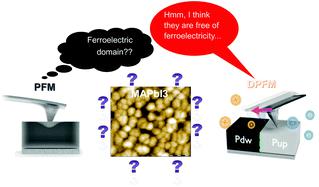当前位置:
X-MOL 学术
›
Energy Environ. Sci.
›
论文详情
Our official English website, www.x-mol.net, welcomes your feedback! (Note: you will need to create a separate account there.)
Reply to the “Comment on the publication ‘Ferroelectricity-free lead halide perovskites’ by Gomez et al.” by Colsmann et al.
Energy & Environmental Science ( IF 32.5 ) Pub Date : 2020-05-29 , DOI: 10.1039/d0ee00880j Andrés Gómez 1, 2, 3 , Qiong Wang 4, 5, 6, 7 , Alejandro R. Goñi 1, 2, 3, 8, 9 , Mariano Campoy-Quiles 1, 2, 3 , Antonio Abate 4, 5, 6, 7, 10
Energy & Environmental Science ( IF 32.5 ) Pub Date : 2020-05-29 , DOI: 10.1039/d0ee00880j Andrés Gómez 1, 2, 3 , Qiong Wang 4, 5, 6, 7 , Alejandro R. Goñi 1, 2, 3, 8, 9 , Mariano Campoy-Quiles 1, 2, 3 , Antonio Abate 4, 5, 6, 7, 10
Affiliation

|
The existence of ferroelectricity in organic–inorganic perovskite thin films has been under debate over the past few years. If proven to exist, its magnitude in comparison to other known processes occurring in perovskite, such as electronic and ionic conductivities, will determine its importance for their optoelectronic properties. In a recent paper, our group aimed at contributing to the understanding of this topic by extending the range of measurements beyond what is conventionally carried out. In particular, we employed three techniques, namely, direct piezoelectric force microscopy, piezoelectric force microscopy, and electrostatic force microscopy, which we applied to two perovskite materials, prepared with control of film thickness and grain sizes that enabled the evaluation of morphological differences. Based on our experimental data, we concluded that lead halide perovskites are ferroelectricity-free.
中文翻译:

回复“对Gomez等人发表的出版物“无铁电的卤化钙钛矿钙钛矿”的评论。” 由Colsmann等人撰写。
在过去的几年中,有机-无机钙钛矿薄膜中铁电的存在一直存在争议。如果证明存在,那么与钙钛矿中发生的其他已知过程(例如电导率和离子电导率)相比,其大小将决定其对其光电性能的重要性。在最近的一篇论文中,我们的小组旨在通过将测量范围扩展到常规范围之外,以促进对该主题的理解。特别是,我们采用了三种技术,即直接压电力显微镜,压电力显微镜和静电力显微镜,将它们应用于两种钙钛矿材料,并通过控制膜厚和晶粒尺寸来制备,从而能够评估形态差异。根据我们的实验数据,
更新日期:2020-06-19
中文翻译:

回复“对Gomez等人发表的出版物“无铁电的卤化钙钛矿钙钛矿”的评论。” 由Colsmann等人撰写。
在过去的几年中,有机-无机钙钛矿薄膜中铁电的存在一直存在争议。如果证明存在,那么与钙钛矿中发生的其他已知过程(例如电导率和离子电导率)相比,其大小将决定其对其光电性能的重要性。在最近的一篇论文中,我们的小组旨在通过将测量范围扩展到常规范围之外,以促进对该主题的理解。特别是,我们采用了三种技术,即直接压电力显微镜,压电力显微镜和静电力显微镜,将它们应用于两种钙钛矿材料,并通过控制膜厚和晶粒尺寸来制备,从而能够评估形态差异。根据我们的实验数据,



























 京公网安备 11010802027423号
京公网安备 11010802027423号